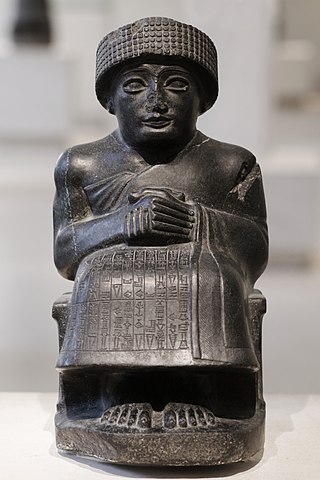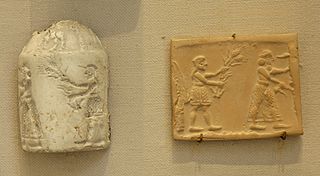En-nun-tarah-ana of Uruk was the ninth Sumerian ruler in the First Dynasty of Uruk (ca. 26th century BC) According to the Sumerian King List , he reigned for 8 years. [1]

Sumer is the earliest known civilization in the historical region of southern Mesopotamia, emerging during the Chalcolithic and early Bronze Ages between the sixth and fifth millennium BC. It is one of the cradles of civilization in the world, along with ancient Egypt, Elam, the Caral-Supe civilization, Mesoamerica, the Indus Valley civilisation, and ancient China. Living along the valleys of the Tigris and Euphrates rivers, Sumerian farmers grew an abundance of grain and other crops, the surplus from which enabled them to form urban settlements. Proto-writing dates back before 3000 BC. The earliest texts come from the cities of Uruk and Jemdet Nasr, and date to between c. 3500 and c. 3000 BC.

The Sumerian King List or Chronicle of the One Monarchy is an ancient literary composition written in Sumerian that was likely created and redacted to legitimize the claims to power of various city-states and kingdoms in southern Mesopotamia during the late third and early second millennium BC. It does so by repetitively listing Sumerian cities, the kings that ruled there, and the lengths of their reigns. Especially in the early part of the list, these reigns often span thousands of years. In the oldest known version, dated to the Ur III period but probably based on Akkadian source material, the SKL reflected a more linear transition of power from Kish, the first city to receive kingship, to Akkad. In later versions from the Old Babylonian period, the list consisted of a large number of cities between which kingship was transferred, reflecting a more cyclical view of how kingship came to a city, only to be inevitably replaced by the next. In its best-known and best-preserved version, as recorded on the Weld-Blundell Prism, the SKL begins with a number of fictional antediluvian kings, who ruled before a flood swept over the land, after which kingship went to Kish. It ends with a dynasty from Isin, which is well-known from other contemporary sources.

The history of Sumer spans the 5th to 3rd millennia BCE in southern Mesopotamia, and is taken to include the prehistoric Ubaid and Uruk periods. Sumer was the region's earliest known civilization and ended with the downfall of the Third Dynasty of Ur around 2004 BCE. It was followed by a transitional period of Amorite states before the rise of Babylonia in the 18th century BCE.

Uruk, today known as Warka, was an ancient city of Sumer situated east of the present bed of the Euphrates River on the dried-up ancient channel of the Euphrates 30 km (19 mi) east of modern Samawah, Al-Muthannā, Iraq.

Elulu is listed as the third king of the First Dynasty of Ur on the Sumerian king list, which states he reigned for 25 years.

Lugal-Zage-Si of Umma was the last Sumerian king before the conquest of Sumer by Sargon of Akkad and the rise of the Akkadian Empire, and was considered as the only king of the third dynasty of Uruk, according to the Sumerian King List. Initially, as king of Umma, he led the final victory of Umma in the generation-long conflict with the city-state Lagash for the fertile plain of Gu-Edin. Following up on this success, he then united Sumer briefly as a single kingdom.

Lugalbanda was a deified Sumerian king of Uruk who, according to various sources of Mesopotamian literature, was the father of Gilgamesh. Early sources mention his consort Ninsun and his heroic deeds in an expedition to Aratta by King Enmerkar.
Aratta is a land that appears in Sumerian myths surrounding Enmerkar and Lugalbanda, two early and possibly mythical kings of Uruk also mentioned on the Sumerian king list.

Tirigan was the 19th and last Gutian ruler in Sumer mentioned on the "Sumerian King List" (SKL). According to the SKL: Tirigan was the successor of Si'um. Tirigan ruled for 40 days before being defeated by Utu-hengal of Uruk, c. 2050 BC.

Dumuzid, titled the Fisherman, was a legendary Sumerian king of Uruk listed originating from Kuara. According to legend, in the one-hundredth year of his reign, he was captured by Enmebaragesi.
Ur-Nungal of Uruk was the sixth Sumerian ruler in the First Dynasty of Uruk, according to the Sumerian King List, which also claims he ruled 30 years. Both the Sumerian King List and the Tummal Chronicle state he was the son of Gilgamesh, but only the Sumerian King List records he was the father of Udul-kalama.

Meshkiangasher was a legendary king mentioned in the Sumerian King List as the priest of the Eanna temple in Uruk, whose journey led him to the enter the sea and ascend the mountains.
Udul-kalama of Uruk was the seventh Sumerian ruler in the First Dynasty of Uruk, according to the Sumerian King List. He was a son of Ur-Nungal and grandson of Gilgamesh. However, unlike his predecessors, he left no other known documents or relics mentioning his name, and he may have been one of several minor kings of Uruk added to the list, who reigned when hegemony was actually held by the first dynasty of Ur.
La-ba'shum of Uruk was the eighth Sumerian ruler in the First Dynasty of Uruk, according to the Sumerian King List.
Melem-Ana of Unug was the 11th lugal of the First Dynasty of Uruk. He ruled in Mesopotamia in modern-day Iraq. Little is known about Melem-ana.
Lugal-kitun was the 12th and last lugal of the first Dynasty of Uruk. He ruled in Mesopotamia in modern-day Iraq. Little is known about Lugal-kitun.

Lugal-kinishe-dudu also Lugal-kiginne-dudu , was a King and (ensi) of Uruk and Ur who lived towards the end of the 25th century BCE. The Sumerian King List mentions Lugal-kinishe-dudu as the second king of the dynasty after En-cakanca-ana, attributing to him a fanciful reign of 120 years.

Lugal-kisalsi, also Lugaltarsi was a King of Uruk and Ur who lived towards the end of the 25th century BCE, succeeding his father Lugal-kinishe-dudu, according to contemporary inscriptions, although he does not appear in the Sumerian King List. In one of his inscriptions, he appears as "Lugalkisalsi, the first-born son of Lugalkigenedudu, king of Uruk and Ur".
Ur-nigin, also Ur-nigina or Ur-nigar was a Governor (ensi) of Uruk who lived in 22nd century BCE.
Ur-gigir was the son of Ur-nigin and a Governor (ensi) of Uruk who lived in 22nd century BCE.